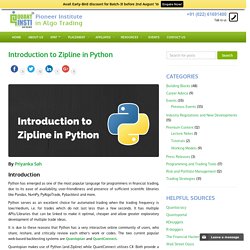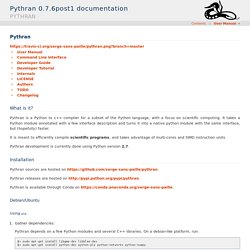

GitHub - fogleman/PirateMap: Procedurally generate pirate treasure maps. Docopt/docopt. Vector animations with Python - __del__( self ) I am a big fan of Dave Whyte’s vector animations, like this one: It was generated using a special animation language called Processing (here is Dave’s code).

While it seems powerful, Processing it is not very elegant in my opinion ; this post shows how to do similar animations using two Python libraries, Gizeh (for the graphics) and MoviePy (for the animations). Gizeh and Moviepy Gizeh is a Python library I wrote on top of cairocffi ( a binding of the popular Cairo library) to make it more intuitive. To make a picture with Gizeh you create a surface, draw on it, and export it: We obtain this magnificent Japanese flag: To make an animation with MoviePy, you write a function make_frame which, given some time t, returns the video frame at time t: Example 1 We start with an easy one. Example 2 Now there are more circles, and we start to see the interest of making animations programmatically using for loops. Example 3 Example 4 Example 5 Example 6 You can draw more than circles !
[1606.09225] Quintuple: a Python 5-qubit quantum computer simulator to facilitate cloud quantum computing. Introduction to Zipline: A Trading Library for Python. By Priyanka Sah Introduction Python has emerged as one of the most popular language for programmers in financial trading, due to its ease of availability, user-friendliness and presence of sufficient scientific libraries like Pandas, NumPy, PyAlgoTrade, Pybacktest and more.

Python serves as an excellent choice for automated trading when the trading frequency is low/medium, i.e. for trades which do not last less than a few seconds. It has multiple APIs/Libraries that can be linked to make it optimal, cheaper and allow greater exploratory development of multiple trade ideas. It is due to these reasons that Python has a very interactive online community of users, who share, reshare, and critically review each other’s work or codes. Quantopian makes use of Python (and Zipline) while QuantConnect utilises C#. Zipline is a Python library for trading applications that powers the Quantopian service mentioned above. This article is divided into the following four sections: Benefits of Zipline #code. Pythran — Pythran 0.7.6post1 documentation. What is it?

Pythran is a Python to c++ compiler for a subset of the Python language, with a focus on scientific computing. It takes a Python module annotated with a few interface description and turns it into a native python module with the same interface, but (hopefully) faster. It is meant to efficiently compile scientific programs, and takes advantage of multi-cores and SIMD instruction units. Pythran development is currently done using Python version 2.7. Installation Pythran sources are hosted on Pythran releases are hosted on. Chriskiehl/Gooey.
Scikit-Learn donne de l’intelligence à nos systèmes. Logiciel Scikit-Learn est une bibliothèque de modèles d’apprentissage statistique – ou machine learning – développée grâce au langage de programmation Python.

Cet outil open source, développé sous l’impulsion de l’équipe Parietal, rencontre un franc succès. Franc succès pour Scikit-Learn lors de la dernière conférence Strata, en février 2014. Enthousiastes, les participants ont plébiscité à la fois son caractère innovant et sa facilité d’utilisation. Avant de rencontrer son public, cette solution logicielle a pourtant mis du temps à trouver son régime de croisière. Un outil plébiscité par toute une communauté Exemples de classification de données (données brutes à gauche) produits par Scikit-Learn Le projet a très vite mobilisé des contributeurs externes du monde entier. « Il s’agit, pour la plupart, de chercheurs ou d’étudiants en thèse travaillant sur les analyses automatique de textes, la vision artificielle, les données génétiques, etc., précise Olivier Grisel.
SciPy.org — SciPy.org. Biopython. BIOSERVICES: a Python package to access biological web services programmatically — bioservices 1.2.0 documentation. Overview BioServices is a Python package that provides access to many Bioinformatics Web Services (e.g., UniProt) and a framework to easily implement Web Service wrappers (based on WSDL/SOAP or REST protocols).

The primary goal of BioServices is to use Python as a glue language to provide a programmatic access to Biological Web Services. By doing so, elaboration of new applications that combine several Web Services should be fostered. One of the main philosophy of BioServices is to make use of the existing REST or SOAP/WSDL Web Services and therefore existing databases, not to re-invent new databases. The first release of BioServices provides a wrapping to more than 18 Web Services (more if we consider BioMart and PSICQUIC portals that link to many other Web Services). The Web framework for perfectionists with deadlines. Python Extension Packages. By Christoph Gohlke, Laboratory for Fluorescence Dynamics, University of California, Irvine.

This page provides 32- and 64-bit Windows binaries of many scientific open-source extension packages for the official CPython distribution of the Python programming language. The files are unofficial (meaning: informal, unrecognized, personal, unsupported, no warranty, no liability, provided "as is") and made available for testing and evaluation purposes.
If downloads fail reload this page, enable JavaScript, disable download managers, disable proxies, clear cache, and use Firefox. Please only download files manually as needed. Most binaries are built from source code found on PyPI or in the projects public revision control systems. Refer to the documentation of the individual packages for license restrictions and dependencies. Use pip version 8 or newer to install the downloaded .whl files. Install numpy+mkl before other packages that depend on it. Build Environment. Python for Scientific Computing. Python programming language. Welcome to Fabric! — Fabric documentation.